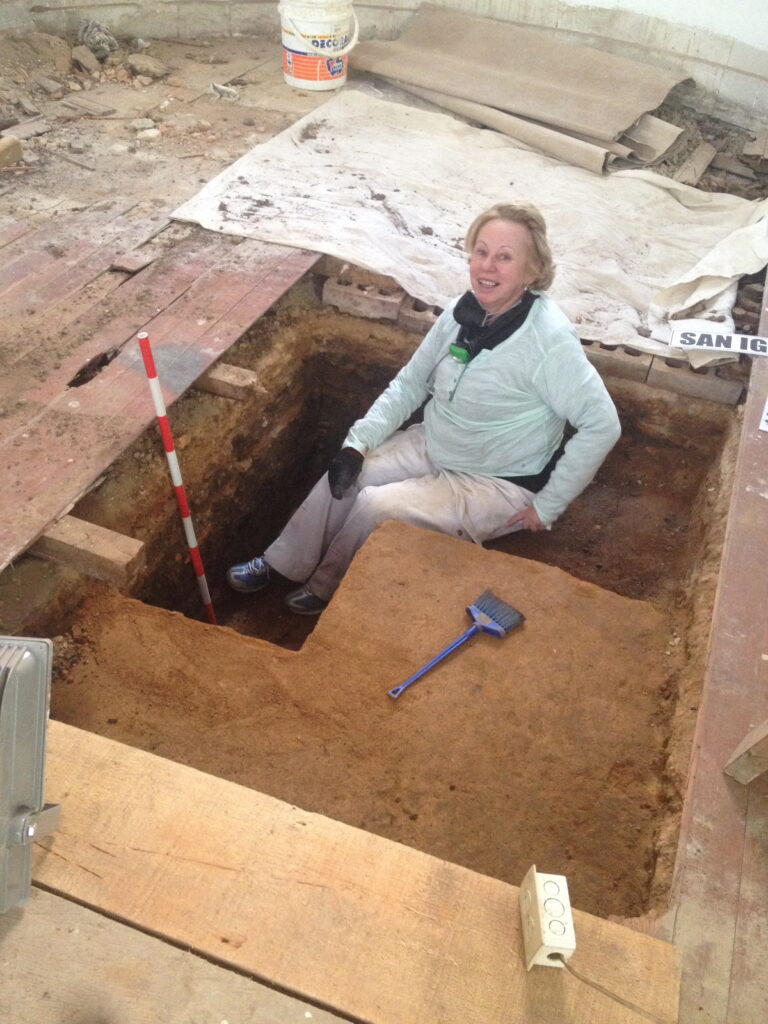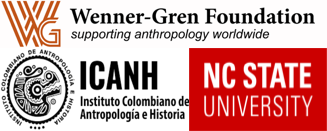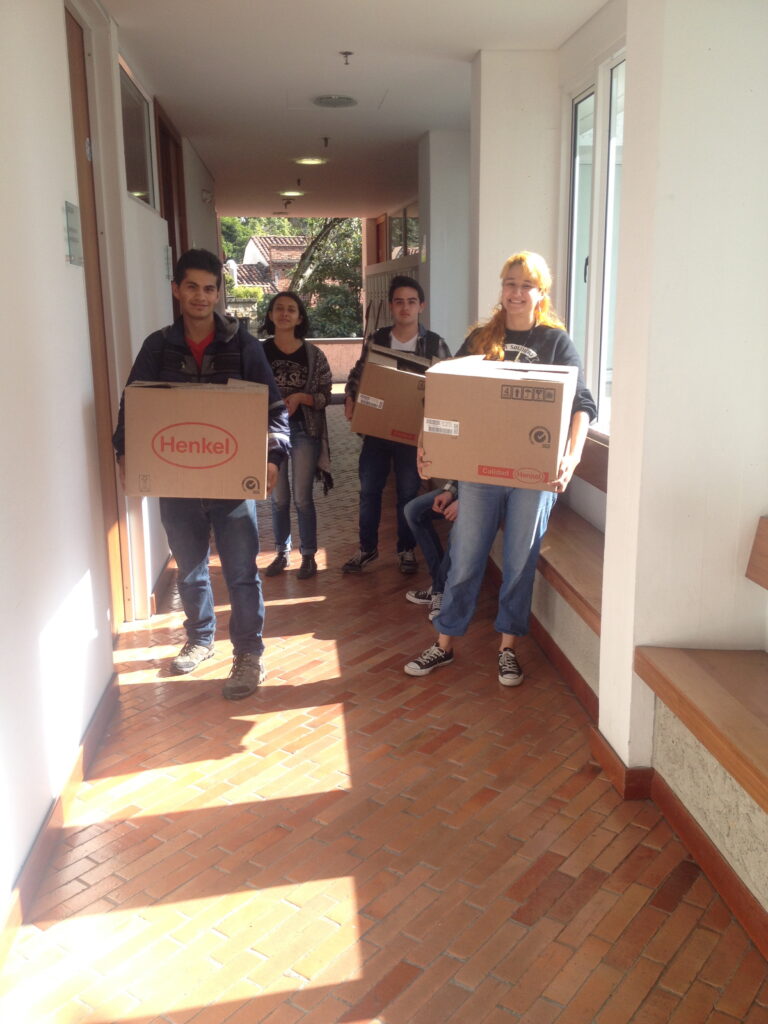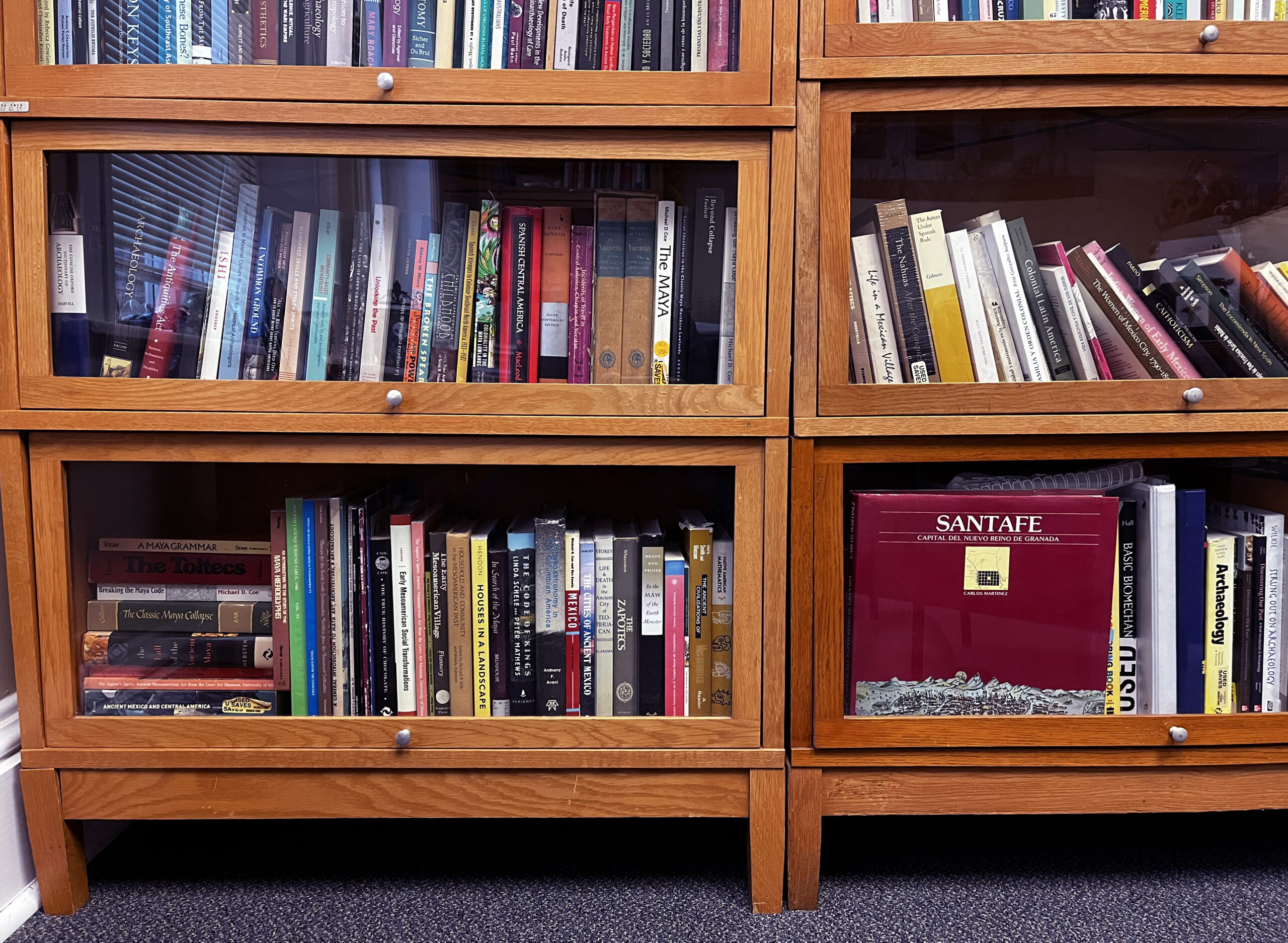About the Project
Sobre el Proyecto
The San Ignacio Church Archaeological Project was initially launched in June 2016 as a short-term research program tied to the comprehensive restoration of the San Ignacio Jesuit church in Bogotá, Colombia. It has, since then, significantly expanded and established itself as an inspiring example of how wide-ranging archaeological investigations can contribute to the development of heritage studies in large and complex urban centers, in Latin America and beyond. Overstepping the practical boundaries generally imposed on preventive archaeology programs in Colombia, the San Ignacio project has forged ahead on a challenging –but also immensely gratifying- research path, leading us to a deeper and better understanding of the convoluted past of Bogotá and its people. Building upon archaeological, bioarchaeological, architectural, and historical evidence, inevitably fragmented by the passage of time, we seek to recreate the intimate life stories of mostly anonymous individuals with whom we can identify in the present, thus highlighting the mission that archaeological research is called to play as a promoter of social cohesion in the contemporary world. Today, more than ever, Colombian society seeks to reconcile itself with its past through the exercise of memory –a memory that tends to be short and selective, but that can also be revitalized through narratives drawn from the archaeological record.

Felipe Gaitán y Catalina Hernández dan un tour por el laboratorio y discuten la conservación de textiles
We firmly believe that, when archaeological data confers with other types of evidence, such as the one found in oral accounts, written documents, and other sorts of historical sources, we come upon an ideal setting allowing us to develop new and richly textured versions of the past. This posture resonates with the conceptual foundation of historical archaeology –the very discipline whose enormous potential we aim at highlighting in this project. What we want to make available to the general public through this webpage is, therefore, a network of narratives that, for centuries, remained hidden under the floors and foundations of the San Ignacio Jesuit church, one of the oldest and most iconic monuments in Bogota. Above all, we value the opportunity to reconstruct such narratives as a rare privilege, culminating in what we praise as a model of trans-disciplinary, trans-institutional and trans-generational collaboration.

Elena Uprimny excavando en San Ignacio
Many people and institutions should be thanked for their support in this endeavor. First and foremost, we want to express our deepest appreciation to architect Ernesto Moure for inviting us to work along with him in San Ignacio. His unparalleled flair and sensitivity to archaeological research were essential in giving us a voice and presence in what remains the most ambitious restoration project carried out in Colombia to this date. Archaeologist Elena Uprimny, one of the founders of historical archaeology in this country, also deserves a heartfelt recognition for her hard work and unfailing support during the early phases of this research. We are indebted to the local chapter of the Society of Jesus and, especially, to Fathers Germán Bernal and Santiago Tobón for their infinite generosity and enthusiasm in keeping the doors of San Ignacio open to archaeological investigation.
This is also an appropriate space to celebrate the tenacity of an exceptional team of students who were formed as professional anthropologists in the light of San Ignacio. Throughout the years, their passion and dedication to this project, whether in the field, in the archive or in the lab, have been essential to its growth. Their undergraduate and graduate works represent fine examples of avant garde archaeological research which are destined to make important contributions to the field of anthropology and historical archaeology in the Hispanic world, beyond the guidance and specific interests of more senior members of the San Ignacio Project. As a team, however, our commitment to the project has led us to earn important academic distinctions awarded by the Wenner-Gren Foundation in New York, and the National Institute of Anthropology and History of Colombia –ICANH.
We invite you to delve into the deep past of San Ignacio and Bogotá, and to listen to the humble voice of archaeological fragments who, despite their unassuming appearance, invisible to the eyes of most, carry the living memory of the Colombian nation and of its fascinating capital city.
Research Grants:

- Wesp, Julie K. and Justin Johnson. (2021). Non-Laboratory Scholarship/Research Program (NSRP), Office of Research and Innovation and Office of the Vice Chancellor and Provost, NCSU. Digital Palimpsests of Cultural Heritage: Developing a virtual experience through time of the Templo de San Ignacio in Bogotá, Colombia
- Gaitán Ammann, Felipe, Julie K. Wesp, and Jimena Lobo Guerrero (2018). Wenner-Gren Foundation Post-PhD Research Grant. Set in Lime: an Archaeology of Life and Death at the San Ignacio Jesuit Church (Bogotá, Colombia), grant #9596
- Gaitán Ammann, Felipe. (2018). Estímulo para la Investigación en Antropología. Instituto Colombiano de Antropología e Historia (ICANH). Determinación de sexo por ADN en la muestra bioarqueológica del Templo de San Ignacio de Bogotá: un primer paso en la documentación científica de los rituales funerarios en la Santafé del siglo XVII.
- León, Tania Cristina. (2018). Estímulo para la investigación de jóvenes investigadores – Instituto Colombiano de Antropología e Historia. Título del proyecto: “Alfarería Jesuita en la Santafé Colonial: siglos XVII y XVIII0
- Wesp, Julie K. (2018). College of Arts and Sciences Mellon Fund Faculty Research Grant, American University. Set in Lime: a Bioarchaeology of Life and Death in Colonial Bogotá, Colombia.
___________________________________________________________
Desde su inauguración en junio de 2016, el Proyecto Arqueológico Iglesia de San Ignacio se ha consolidado como un ejemplo de lo que una investigación arqueológica de amplia envergadura puede lograr dentro del marco de los estudios históricos y patrimoniales de una urbe tan compleja como Bogotá. Trascendiendo los límites prácticos generalmente impuestos a los programas de arqueología preventiva en Colombia, este proyecto se encaminó por un camino largo, tortuoso, pero sin duda maravilloso, que nos ha permitido reconocer y hasta cierto punto comprender, el pasado profundo de esta ciudad. A partir de una evidencia necesariamente fragmentada y desfigurada por el paso del tiempo, hemos procurado construir narrativas amplias y diversas con las cuales nos podamos identificar desde el presente, resaltando así la misión social que la investigación arqueológica está llamada a cumplir en el mundo contemporáneo. Hoy, más que nunca, la sociedad colombiana busca reconciliarse con su pasado a través del ejercicio de la memoria –una memoria que suele ser en extremo corta y selectiva, pero que también puede ser revitalizada con base en los datos materiales que componen el registro arqueológico. Y así, cuando la información arqueológica entra en diálogo con aquella proveniente de otro tipo de fuentes, propias de la historiografía y de la historia del arte, se crean unas condiciones idóneas para generar un conocimiento rico en matices sobre el pasado reciente. Este es, precisamente, el fundamento conceptual sobre el que se erige la disciplina que denominamos arqueología histórica, y cuyo enorme potencial para nutrir nuestra memoria hemos buscado resaltar en este proyecto.

Padre Germán Bernal, antiguo director de San Ignacio, aportó un apoyo firme a este proyecto arqueológico
Lo que aquí buscamos poner al alcance del público general es, por lo tanto, un entramado de historias que, por siglos, permanecieron ocultas y desarticuladas entre los pisos y cimientos de la iglesia de San Ignacio, uno de los monumentos más antiguos e icónicos de Bogotá. El haber tenido la oportunidad de hilarlas desde una perspectiva arqueológica representa para nosotros un increíble privilegio que, en retrospectiva, enaltecemos como un modelo de colaboración trans-disciplinaria, trans-institucional y trans-generacional.
Son muchas las personas e instituciones a quienes deseamos agradecerles su apoyo en el desarrollo de esta investigación. Ante todo, al arquitecto Ernesto Moure, gracias por haber tenido el olfato y la visión necesarias no solamente para darnos acceso a la iglesia de San Ignacio, sino para darle voz a la arqueología en el momento de renegociar la cara visible de lo que hoy por hoy constituye la obra de restauración arquitectónica más larga y ambiciosa que se haya llevado a cabo en el país. El apoyo de la arqueóloga Elena Uprimny, pionera de la arqueología histórica en Colombia, fue fundamental durante la fase de campo de este proyecto y queremos manifestarle aquí nuestro respeto y cariño más sincero. A la Compañía de Jesús, al padre Germán Bernal y, muy especialmente, al padre Santiago Tobón, gracias por mantener las puertas de San Ignacio abiertas a la investigación arqueológica, con infinita generosidad y entusiasmo.

Estudiantes y miembros del proyecto ayudan a trasladar materiales de la iglesia al laboratorio de arqueología de la Universidad de Los Andes, quien amablemente aportó espacio de trabajo entre 2017 y 2020
Este espacio también es importante para celebrar el tesón del fabuloso equipo de estudiantes, hoy en día ya profesionales en antropología, que se formaron y crecieron a la luz de San Ignacio. Su pasión y su dedicación a lo largo de estos años, bien sea en campo, en el archivo o en el laboratorio, han sido esenciales para el éxito de este proyecto; sus investigaciones, lejos de ser pequeños trabajos atados a los designios de sus directivas, constituyen estudios innovadores y creativos de la más alta calidad, destinados a hacer contribuciones importantes dentro del campo de la antropología y la arqueología histórica del mundo hispano. Así, gracias al trabajo de todos y cada uno de sus miembros, el Proyecto San Ignacio se ha hecho merecedor de varias distinciones en Colombia y el exterior, incluyendo una beca de investigación concedida por la Wenner-Gren Foundation en Nueva York, y varios estímulos del Instituto Colombiano de Antropología e Historia –ICANH.
Les invitamos a sumergirse en el pasado profundo de San Ignacio, hecho de pequeños fragmentos, humildes, discretos e invisibles ante los ojos de la mayoría, y que sin embargo, le pertenece a toda la nación colombiana y a todos quienes habitan los múltiples espacios vividos de su ciudad capital.
Becas de Investigación
- Wesp, Julie K. and Justin Johnson. (2021). Non-Laboratory Scholarship/Research Program (NSRP), Office of Research and Innovation and Office of the Vice Chancellor and Provost, NCSU. Digital Palimpsests of Cultural Heritage: Developing a virtual experience through time of the Templo de San Ignacio in Bogotá, Colombia
- Gaitán Ammann, Felipe, Julie K. Wesp, and Jimena Lobo Guerrero (2018). Wenner-Gren Foundation Post-PhD Research Grant. Set in Lime: an Archaeology of Life and Death at the San Ignacio Jesuit Church (Bogotá, Colombia), grant #9596
- Gaitán Ammann, Felipe. (2018). Estímulo para la Investigación en Antropología. Instituto Colombiano de Antropología e Historia (ICANH). Determinación de sexo por ADN en la muestra bioarqueológica del Templo de San Ignacio de Bogotá: un primer paso en la documentación científica de los rituales funerarios en la Santafé del siglo XVII.
- León, Tania Cristina. (2018). Estímulo para la investigación de jóvenes investigadores – Instituto Colombiano de Antropología e Historia. Título del proyecto: “Alfarería Jesuita en la Santafé Colonial: siglos XVII y XVIII0
- Wesp, Julie K. (2018). College of Arts and Sciences Mellon Fund Faculty Research Grant, American University. Set in Lime: a Bioarchaeology of Life and Death in Colonial Bogotá, Colombia.

